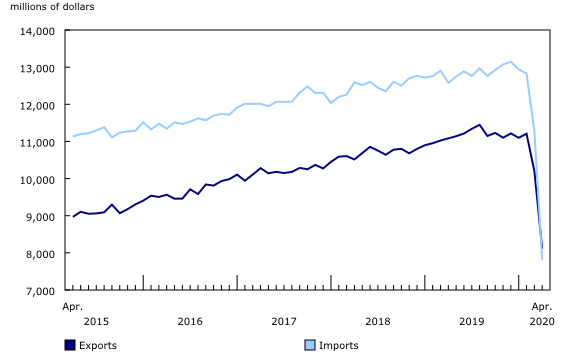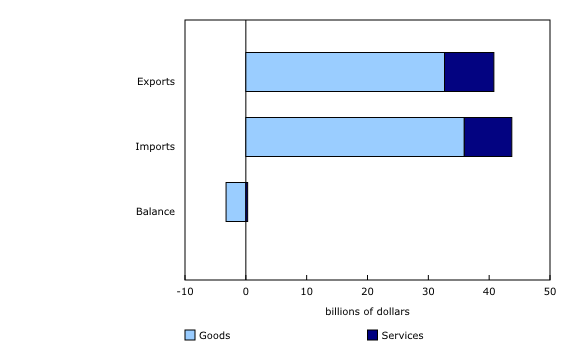Canadian international trade in services, April 2020
Archived Content
Information identified as archived is provided for reference, research or recordkeeping purposes. It is not subject to the Government of Canada Web Standards and has not been altered or updated since it was archived. Please "contact us" to request a format other than those available.
Released: 2020-06-04
Canada's monthly international trade in services balance went from a deficit of $1.1 billion in March to a surplus of $302 million in April. Overall, imports of services fell 30.7% to $7.8 billion and exports declined 20.5% to $8.1 billion, primarily the result of lower travel services. For imports, this was the lowest level observed since July 2009, and for exports, the lowest level since June 2013.
April 2020 was the first complete month where COVID-19-related border closures to non-essential travel were in place for Canada. Those closures, along with the extension of other related measures to close non-essential businesses in April, had significant impacts on Canada's international trade in services.
Imports of travel services fell sharply, down 87.7% to $307 million in April as international travel was restricted to essential travel only. Imports of transportation services decreased 33.7% to $1.5 billion as passenger fares were also negatively impacted by COVID-19-related travel restrictions, and a slowdown in international merchandise trade reduced transportation services payments related to the shipment of goods. Commercial services declined 8.1% to $5.9 billion, as border closures and physical distancing measures restricted business activity.
Exports of travel services were down 54.0% to $1.1 billion as, similarly to imports of travel services, border closures drastically reduced the number of international tourists in Canada.
Within travel services exports, education-related travel reflects the consumption of international students enrolled in studies in Canada and physically located in Canada to attend courses. As a segment of non-resident international students studying in Canada remained in Canada and continued their studies via e-learning or other alternative means, the education component of travel services declined at a slower rate than the non-education component. Exports of travel services declined less than imports in April, as education-related travel services represent a much larger share of overall travel service exports than imports.
Exports of transportation services fell 25.3% to $1.0 billion in April, as both passenger fares and transportation services related to the international transport of goods declined. Exports of commercial services declined 7.7% to $5.9 billion.
In comparison, total exports of goods fell 29.7% to $32.7 billion in April, while total imports of goods declined 25.1% to $35.9 billion, resulting in a goods deficit of $3.3 billion. When combined, the trade balance for goods and services amounted to a deficit of $2.9 billion in April, an increase of $344 million from March.
The services trade deficit for March, first reported at $1.0 billion, was revised up by $86 million with this month's release of April data. Exports of services for March were revised down by $186 million, almost entirely on lower commercial services. Imports of services were revised down by $101 million, as travel services were revised down. This month's release reflects the integration of quarterly benchmark data from the balance of payments for the first quarter of 2020, as well as revisions to all quarters of 2019.
Note to readers
Adjustments to the methodological approach
Circumstances surrounding COVID-19 pose issues for the production of the monthly international trade in services statistics, particularly for travel services and transportation services.
Travel services and the passenger fares component of transportation services are estimated using tourist and traveller counts as indicators of monthly movement. These data are not available on a timely basis and are projected for the reference month before being replaced by the actual values in the following month. This approach worked in a typical month, but would not work in the current situation, where travel restrictions that reduce tourist and traveller numbers have been implemented very rapidly.
In order to better capture the effects of the COVID-19 pandemic, Statistics Canada is incorporating data from the Canada Border Services Agency's Primary Inspection Kiosks in the monthly international trade in services program. These are electronic customs declaration kiosks that are established in most major Canadian airports. While these data represent only a subset of total travellers, they provide relevant and timely insight.
More detailed information on traveller numbers can be found in the Leading indicator of international arrivals to Canada by air, and the Leading indicator of cross-border traveller volume releases.
Additionally, the methodology for the estimation of the monthly international trade in services statistics involves first projecting quarterly benchmark values and then dividing those quarterly values into monthly values using economic indicators. While the projected quarterly value was previously kept constant through the production of all three months of the quarter, with the current volatility, this particular element of the model was revisited and the benchmark values are being adjusted based on the most current data, as needed.
Revisions
Due to the unprecedented circumstances related to the COVID-19 pandemic, larger than typical revisions may occur in subsequent months as additional, but less timely, indicator data are incorporated into the monthly services program.
Methodology
Because several data sources used to compile the international trade in services program are only available on a quarterly or annual basis, the monthly statistics on Canada's international trade in services are generated using models when up-to-date information is not available. This follows the methodology used in many countries that produce monthly trade in services data.
In general, for most of the commercial services, travel, and some transport services, the modelling of monthly estimates follows a three-step approach. First, values for the upcoming quarter are estimated using statistical models (auto-regressive integrated moving average). Second, indicator series that proxy the monthly movement of trade in services are identified through relationships with other economic indicators, such as merchandise trade or gross domestic product by industry. Finally, a temporal disaggregation method (the Denton-Cholette method) is applied to distribute modelled quarterly services on a monthly basis, using the predicted values of monthly services generated in the second step. Adjustments are made each month as new information becomes available.
A more detailed description of estimation methodology for monthly trade in services is available upon request.
Products
The updated Canada and the World Statistics Hub (13-609-X) is available online. This product illustrates the nature and extent of Canada's economic and financial relationship with the world, using interactive graphs and tables. This product provides easy access to information on trade, investment, employment and travel between Canada and a number of countries, including the United States, the United Kingdom, Mexico, China, Japan, Belgium, Italy, the Netherlands and Spain.
The Methodological Guide: Canadian System of Macroeconomic Accounts (13-607-X) is available.
The User Guide: Canadian System of Macroeconomic Accounts (13-606-G) is also available. This publication will be updated to maintain its relevance.
Contact information
For more information, contact us (toll-free 1-800-263-1136; 514-283-8300; STATCAN.infostats-infostats.STATCAN@canada.ca).
To enquire about the concepts, methods or data quality of this release, contact Alec Forbes (613-668-6454; alec.forbes@canada.ca), International Accounts and Trade Division.
- Date modified:





